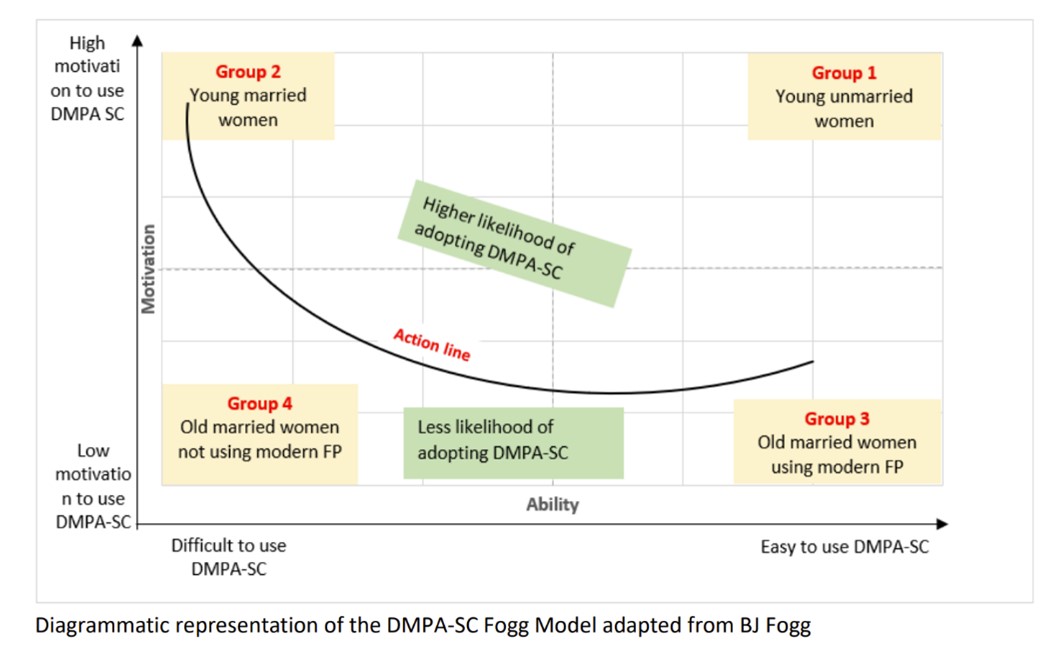Country focus: Nigeria
Theme: Family Planning
Authors: Aisiri Adolor; Fagbemi Babafunke; Olarewaju Olajumoke; Laleye Oluwatofunmi; Uzoh-Ntiwunka Adaora
Author affiliations: Centre for Communication and Social Impact (CCSI), Abuja Nigeria.
In Brief
The CCSI team built Responsive Feedback into their program to increase women and girls’ uptake of self-injectable contraceptive methods. This allowed them to use data to adjust their initial intervention approach, to re-prioritize focus groups and create nuanced interventions according to new learnings about the different groups. In embracing RF, the CCSI team were able to better understand their audience and embrace change.
Background
The Centre for Communication and Social Impact (CCSI) is implementing the SBCC component of the Resilient & Accelerated Scale-up of injectable contraceptives in Nigeria (RASuDiN Project) across 10 states in Nigeria. The objective of this project is to increase Nigerian women and girls’ uptake of modern contraceptives.
Program Approach
The Theory of Change (ToC) was based on the Fogg Behavior Model (FBM), which theorizes that motivations, ability, and trigger are needed for a desired behavior to occur. This led the team to form two key learning questions for the program:
- What category of women audience segment are more likely to use DMPA-SC?
- What are the effects of the FBM elements on the use of DMPA-SC?
To answer these, the target audience was segmented into quadrants according to data on why women use FP methods: (1) young, unmarried; (2) young, married; (3) old, married women using modern FP; (4) old, married women not using modern FP.

Young women (groups 1 and 2) were prioritized in the initial intervention on the premise that they had the highest motivation to uptake contraceptive methods.
How did the program harness responsive feedback?
At the program design phase, CCSI secured donor buy-in and understanding of RF. RF mechanisms were built into the program so that the team could review impact and revise their intervention design accordingly.
The data collected after phase one identified that the highest motivation did not correlate with age, but with marital status. For example, 53% of young, single women reported low motivation, low ability to use modern contraceptives. The team’s initial assumption that young, single women had high motivation to use family planning was incorrect. Single women felt reluctant to use family planning due to social stigma associated with the very public ways that women were required to access the contraception. By embracing the learning from data, the CCSI team were able to shift their initial intervention design to effectively re-prioritize audience groups and tailor messaging to them.
How they evolved
By understanding their target audience, the team were able to make two core tweaks to the program:
- Nurture the motivation of single women. The team harnessed communications strategies on social media to enhance young, single women’s engagement and relation with the scheme, chosen as a more private, accessible approach. The RASuDiN radio program “Na who I go ask? Na person wey Sabi” was one of these.
- The provider began going into communities. This meant that married women could access contraceptives without needing to visit facilities. These provisions were adjusted in line with findings that married women had the motivation and so their ability was best fostered.
The results
RF enabled the team to better understand their target audience and adjust their second round of intervention accordingly. Findings from Phase 2 data showed that tailored approaches were effective in nurturing the necessary motivation and ability depending on audience quadrant. For example, old, married women reporting low motivation, low ability decreased from 63% to 38% in the second phase.
Lessons for others:
- Data can shift intervention design: The CCSI team uncovered opportunities to better understand their target audience, tweak concepts, and create new interventions accordingly. The introduction of a social media strategy for one quadrant is exemplary of this.
- Leverage existing resources: CCSI accommodated for RF in the budget by integrating the mechanism into routine program activities. This avoided duplication of roles, saved extra cost and prevented the creation of parallel systems between the RASuDiN project and the RFM system.
FIND OUT MORE
Contact Aisiri Adolor at aaisiri@ccsimpact.org